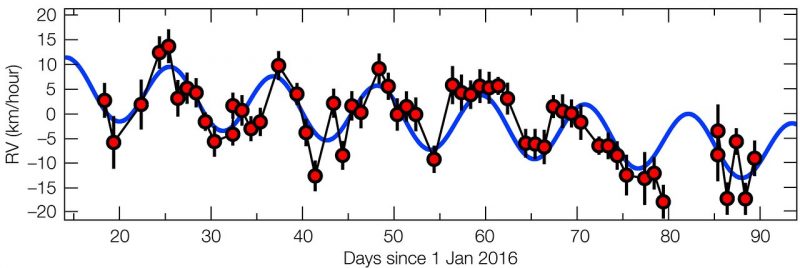
We started hearing rumors last week that a planet had been found in the habitable zone of the next-nearest star, Proxima Centauri, only 4 light-years away. The rumors swirled around an observing campaign called Pale Red Dot, begun in early 2016 under the auspices of the European Southern Observatory (ESO). Pale Red Dot’s goal was, specifically, to find a planet for this star. Now ESO and several other institutions have released statements on the new discovery. Yes, there is a new planet. Yes, it’s only slightly more massive than Earth. Yes, it’s in Proxima Centauri’s habitable zone, meaning there’s a potential for liquid water to exist on its surface.
The journal Nature is due to publish a paper describing the new planet – which is called Proxima b – on August 25, 2016. ESO said:
The long-sought world … orbits its cool red parent star every 11 days and has a temperature suitable for liquid water to exist on its surface. This rocky world is a little more massive than the Earth and is the closest exoplanet to us — and it may also be the closest possible abode for life outside the solar system.

Wait, you might be saying. Isn’t Alpha Centauri the nearest star besides our sun? Yes, but it’s a triple system. Of the three stars in the system, Proxima – a small red dwarf star – is the closest star. Read about the Alpha Centauri system.
Also, you might have heard reports four years ago of an Earth-like exoplanet orbiting Alpha Centauri B. Astronomers later learned that – if it existed at all, which it may not – this earlier planet would be too hot to sustain liquid water or life.
ESO described Pale Red Dot, the recent planet search around Proxima Centauri, this way:
During the first half of 2016 Proxima Centauri was regularly observed with the HARPS spectrograph on the ESO 3.6-meter telescope at La Silla in Chile and simultaneously monitored by other telescopes around the world. This was the Pale Red Dot campaign, in which a team of astronomers led by Guillem Anglada-Escudé, from Queen Mary University of London, was looking for the tiny back and forth wobble of the star that would be caused by the gravitational pull of a possible orbiting planet.

Guillem Anglada-Escudé explained the background of this unique search:
The first hints of a possible planet were spotted back in 2013, but the detection was not convincing. Since then we have worked hard to get further observations off the ground with help from ESO and others. The recent Pale Red Dot campaign has been about two years in the planning.
When combined with earlier observations, the Pale Red Dot data revealed the new planet, ESO said, explaining:
At times Proxima Centauri is approaching Earth at about 3 miles (5 km) per hour — normal human walking pace — and at times receding at the same speed. This regular pattern of changing radial velocities repeats with a period of 11.2 days. Careful analysis of the resulting tiny Doppler shifts showed that they indicated the presence of a planet with a mass at least 1.3 times that of the Earth, orbiting about 4 million miles (7 million km) from Proxima Centauri — only 5% of the Earth-sun distance.
Guillem Anglada-Escudé said:
I kept checking the consistency of the signal every single day during the 60 nights of the Pale Red Dot campaign. The first 10 were promising, the first 20 were consistent with expectations, and at 30 days the result was pretty much definitive, so we started drafting the paper!
ESO commented that this discovery is bound to kick off extensive further observations, both with current instruments and with a coming generation of giant telescopes.
And for those engaged in SETI – the search for extraterrestrial lifeforms – for the moment at least, all eyes on Proxima Centauri and its new planet!

Bottom line: Astronomers with the Pale Red Dot campaign of the European Southern Observatory announced the discovery of a planet for Proxima Centauri, the next-nearest star besides our sun. For the moment, they’re calling the planet Proxima b.











